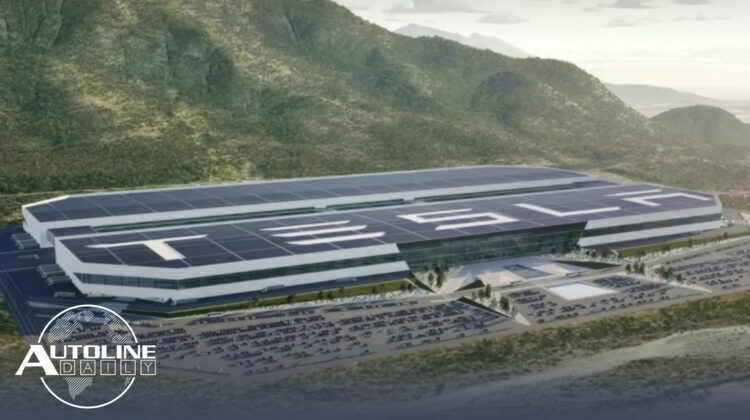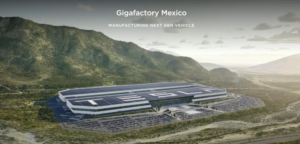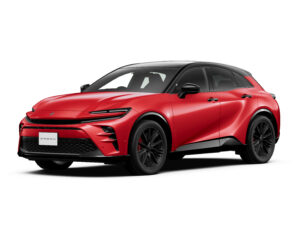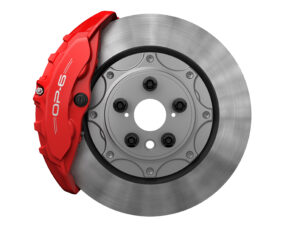
Follow us on social media:
Runtime: 10:54
0:00 Tesla Mexico Takes a Siesta
1:06 UAW’s Fain Shows Up on VW’s Doorstep
2:21 Germany Yanks EV Subsidies
3:12 Nikola’s Trevor Milton Gets Prison Sentence
4:46 Manchin Says No to All Chinese Battery Materials
5:35 NIO Takes Drive-By-Wire to New Level
6:40 Chrysler to Give Pacifica Significant Refresh
7:30 Toyota Adds PHEV to Crown Sport Lineup
8:53 Generative AI Slashes Forvia’s R&D Costs
9:33 Sandy Munro on AAH
Visit our sponsors to thank them for their support of Autoline Daily: Bridgestone and Intrepid Control Systems.
This is Autoline Daily, the show dedicated to enthusiasts of the global automotive industry.
TESLA MEXICO TAKES A SIESTA
When is Tesla ever going to build that gigafactory in Mexico? In March, it announced it would build an assembly plant in Nuevo Leon, and there was talk it would start building cars there in about a year. But not much has happened. Tesla has a reputation for building plants at break-neck speed, but it hasn’t been that way with this one. Right now it’s not expected to open until 2025 or even 2026. And part of the problem is getting all the proper permits. But Elon Musk also deliberately slowed the investment in the plant, citing high interest rates and uncertainty with the global economy. Tesla’s revolutionary assembly process, called unboxed, was supposed to debut at the Mexican plant to build a $25,000 car that some call the Model 2. But now Musk says that the $25,000 car will first be built in Austin, Texas.
UAW’S FAIN SHOWS UP ON VW’S DOORSTEP
Speaking of Musk, maybe he’s a bit worried about the UAW making inroads into Tesla. The company is giving workers at its battery plant in Nevada a 10% raise in January, and some are going to get a raise of more than $8 an hour. Meanwhile, the UAW seems to be making progress in its attempt to unionize Volkswagen’s manufacturing complex in Chattanooga, Tennessee. UAW President Shawn Fain was in Chattanooga to deliver a letter demanding the company give up its union-busting activities–something the company strongly denies. Fain’s presence suggests the UAW got 50% of the workers at the plant to sign cards saying they want a union. He said he would personally go to plants that hit that 50% threshold. In the union’s last livestream Fain said over a thousand VW workers had signed cards in the first week and hundreds more had signed up since. That first thousand represents over 30% workers, so it may have hit that 50% mark, but we still don’t know for sure because the union isn’t saying.
GERMANY YANKS EV SUBSIDIES
It was hard enough for car companies to turn a profit selling EVs. Now, Germany made it even harder. The country just eliminated a 6,750-euro subsidy for purchasing an EV. It says the government can’t afford to pay it. So a number of automakers say they will pay for the subsidy themselves. Tesla, Volkswagen, Stellantis and Mercedes-Benz will give buyers the full discount for EVs delivered by the end of the year. VW, Stellantis and Mercedes will also provide a reduced subsidy for buyers who purchase an EV through early next year. No doubt other automakers will be forced to follow suit to stay competitive. But this just blew a big hole in all their efforts to sell EVs at a profit.
NIKOLA’S TREVOR MILTON GETS PRISON SENTENCE
Nikola’s founder and former CEO, Trevor Milton, is going to prison. Yesterday, a U.S. district judge in Manhattan sentenced Milton to four years behind bars for misleading shareholders about the development of the company’s products and technology. But the judge did allow Milton to remain free on bail while he appeals the decision. Last year, a jury convicted Milton of securities and wire fraud. Milton claimed he did not intend to mislead investors and blamed his mistakes on his lack of experience as CEO. You may remember that Trevor was a guest on Autoline After Hours before any of these accusations came up. And a number of you called him a fraud then and we should have paid more attention to that. If you were one of those people, pat yourself on the back, because you saw right through that fraudster while companies like General Motors, Bosch and Iveco that did deals with Nikola were taken for a ride.
MANCHIN SAYS NO TO CHINESE BATTERY MATERIALS
Earlier this month, the U.S. Treasury Department issued its EV tax credit guidance which limited the amount of materials batteries can contain from China. But it did exempt some trace minerals from China and other Foreign Entities of Concern for two years, because most EVs would have been ineligible to qualify for the incentives. However, Senator Joe Manchin is unhappy with that exemption and is trying to get it reversed. He says it will hurt taxpayers and make it easier for Chinese companies to receive EV tax credits. However, it’s not clear if the Senate can override a Treasury guidance, so yesterday Manchin asked the Government Accountability Office for a legal opinion on the matter. So we’ll have to wait and see how this battle ends up.
NIO TAKES DRIVE-BY-WIRE TO NEW LEVEL
We just saw a massive step forward in automotive electronics with Tesla switching to a 48 volt system in the Cybertruck. And if NIO can deliver on its promises we’ll see another leap two years from now. The Chinese EV startup’s new flagship sedan, called the ET9, is said to be launching in 2025 with a fully wire-controlled chassis. CarNewsChina reports that means most of the cars critical parts, including the throttle, gear shifts, suspension, steering and brakes will all be controlled with electronic inputs, instead of mechanical. The luxury model will also feature its own computing system, called the Vehicle Management Computer that will handle all of these functions, and when combined with the fully wired chassis, it will make integrating other technologies like autonomous driving even easier. The ET9 is meant to compete against high-end luxury cars from Audi, BMW and Mercedes and will use tech like this to set itself apart from the crowd.
CHRYSLER TO GIVE PACIFICA SIGNIFICANT REFRESH
If you hadn’t heard, the final Chrysler 300 rolled off the assembly line recently, which leaves Chrysler with only one model in its lineup, the Pacifica minivan. And according to brand CEO Christine Feuell, it’s only going to have one model for “about a year.” Last month she revealed Chrysler will come out with a BEV in 2025 inspired by the Airflow concept and keep the hybrid version of the Pacifica around until the end of the decade. Feuell is providing even more details about these plans and says a “pretty significant” refresh of the Pacifica will come out some point after it launches the BEV. While we don’t have much to go on, she says it will be more than just a moderate refresh.
TOYOTA ADDS PHEV TO CROWN LINE-UP
Toyota revealed the new plug-in hybrid version of the Crown Sport, we’ve previously shown the standard hybrid model, and it either has some of the biggest brakes in the entire world or there’s a misprint in the press release. It claims the PHEV will have 20-inch ventilated disc brakes and 20-inch aluminum opposing six-piston calipers fitted into 21-inch wheels. We Googled “biggest brakes” and the optional carbon ceramic brakes on the Lamborghini Urus are listed as the biggest at 440mm or 17.3 inches. So, we’ve reached out to Toyota to see if its numbers are correct and while we wait for a response, we can give you some of the other details on the car. It provides AWD drive from a 2.5L engine and electric motor that combine for 225 kW or about 300 horsepower. While Toyota doesn’t say how big the battery is, it says it provides up to 90 km or roughly 56 miles of range. The model will also offer bidirectional charging and a 1,500 watt external power supply. Sales of the Crown Sport PHEV are starting now in Japan with a base price right around $53,000.
GENERATIVE AI SLASHES FORVIA’S R&D COSTS
Automakers and suppliers are playing around with generative AI to figure out how to boost their productivity. Autoline has spoken to various suppliers who are using AI to write code. And Forvia says it thinks AI can cut its R&D costs in half before the end of the decade. But automakers and suppliers have told Autoline that using ChatGPT is dangerous because once you allow it access to your data for analysis, that data is now in the public domain. So all these companies are using their own private, internal generative AI to do the work.
SANDY MUNRO ON AFTER HOURS
The styling of the Cybertruck sure has stirred up a lot of controversy. But it’s probably the most technologically advanced vehicle ever made. And that’s what we’ll be talking about on Autoline After Hours this Thursday with Sandy Munro. Tu Le from Sino Auto Insights will be with us and so will Joe White from Reuters. And they’re going to bring a healthy dose of skepticism with them. So don’t miss out.
And a programming note here. Thursday will be the last day of the year for the Autoline crew but we’ll hit the ground running on January 3rd as we gear up for the convention madness called CES.
And that’s all for today’s show. Thanks for tuning in.
Thanks to our partner for embedding Autoline Daily on its website: WardsAuto.com









Sean, Any further word on Tesla Cyber truck crash testing? I can easily imagine it cutting small cars (Chevy Spark?) in half in collisions, not to mention what it would do to a motorcycle or pedestrian. I’m not even sure commercial buildings are safe. I hope we don’t have to wait until a Cyber truck rips the drive thru window off a McDonalds to find out. PS given the size and weight of the Cyber truck, do you think a dump truck, camper or school bus version is in the works? If anyone wants to do an artist’s impression of that, I would love to see it.
GigaMexico delaying plant is a question to ask Sandy Munro, especially with Tesla changing everything so quickly. Their new robot, changes in automotive manufacturing equipment [of which they own multiple equipment making companies like Toronto Tesla Automation] where will the new equipment go when you have already built the factory. At the Fremont factory they had to put the die casting equipment outside since it was too large to fit in the factory and that was just a few years ago and today they are changing even faster. Amazing when you put a bunch of uber smart people together and not have corporate politics trying to stop them.
Kevin, something like this? https://ibb.co/yfmmHpQ
Or more Semi-based: https://ibb.co/18V1DfG
I’m guessing that Giga Mexico timing has to do with delays in battery cell manufacturing improvements, and the preference of key engineers for working either in California or Texas. And labor is only one part of overall vehicle cost – not the biggest either. If it’s Elon’s hope of using Optimus, good luck with that. And keeping the Neo-Luddites out.
I like the Toyota Crown Sport. It even has decent electric-only range.
Thursday’s AAH should be great, with Tesla fanboy Munro, and a couple people who may not be such fanboys.
In addition to Sean W.’s thoughts, could a reason the Mexican factory is being delayed be that Elon doesn’t think they need the additional capacity right now. Are permits that hard to get in Mexico? Seems unlikely.
I seriously doubt the brakes in the Crown Sport are 20 inch, probably more like16, to fit in 20 inch wheels. Except for the price, and mandatory 4wd, that could be an appealing vehicle to me. It’s almost a wagon, being only 60-61 inches tall from what I can find, a lot lower than most CUVs.
“most technologically advanced vehicle ever made.” I think you need to add word “street” to the statement. I think the current F1 cars are the most technologically advanced vehicles. The light weighting design/materials, bleeding edge aerodynamics and how the power unit reclaims energy from regen and exhaust heat. 30 years ago F1 cars had full active suspension!
In order to fit a 20″ brake rotor inside a 21″ wheel means the caliper has to be less than 1/2″ thick including clearances yet strong enough to clamp down on both sides of the rotor. I doubt very much if that is correct.
Sean …. Excellent!
I wouldn’t be interested in riding or driving the luxury Nio vehicle that is completely drive-by-wire. I do not think such a vehicle would be legal here in the US. I would be too nervous that a system we all take for granted, would fell and my life and those around me would hang in the balance!
I just saw a really good Jay Leno review and test drive of the Cybertruck yesterday on YOUTUBE. Pretty impressive truck and the Tesla chief engineer covered many of details behind the tech. Worth watching.
wmb- I can understand your reluctance to trust a drive-by-wire vehicle. However, you probably already have to a lesser extent. Electronic gas pedals have been around since 1986 first in the BMW 7-series. Shift by wire has been around since 1996 and steering by wire was first used on the Infinity Q50 in 2014. Brake by wire (EBS) been around on trailers for years and in a few vehicles. All these systems have redundancies built in but just like their mechanical counterparts can still fail. I’m not super excited about them either but it seems to be the way of the future.
Anyone happen to see the Movie just released on Netflix called “Leave the world behind”? One scene in the movie as the US is under attack. All the Tesla’s head to a location and start crashing into each other. Another somewhat weird tidbit is the Obama’s are executive producers of the movie too.
I don’t want drive by wire steering, and I’d rather not share the road with 7000 pound tanks that have it. To me, steering and braking by wire are much different from throttle by wire. While Cybertruck may have redundancies for electronics, I doubt that it has triple redundancy for mechanical things, and those can fail.
If you think about it. Hydraulic brakes are likely more dangerous than brake by wire. But only in how it is set up. If, for instance, a brake line corrodes and suddenly fails while stopping…..no brakes. If a wheel cylinder suddenly fails under braking….no brakes. Both of these scenarios have occured to me in the past. No warning, just failure and I zinged through red lights on 2 occasions. With brake by wire, I would assume that if continuity fails, the brakes would lock. Similar to air brakes which have to build pressure to release the brakes and if the air pressure drops, the brakes lock. At least that is how i would set up brake by wire for safety.
Steer by wire failure is a little bit trickier, but not really all that different than mechanical failure issues. If a rag joint fails and you don’t notice symptoms prior to failure….no steering. If the nut holding the steering wheel on loosens, as ford found out, no steering. If you loose electrical continuity on a steer by wire system, you also lose steering but that is not really different than blowing out a rag joint. There is one key difference though, with a steer by wire system, you would self check continuity and not allow the car to be driven at all if the system detects steering system faults. The same will not be said for anyone that has loose steering wheel nuts or failing u-joint/rag joints that they are actively ignoring. Those people will just continue to drive until the wheel literally falls off.
I guess I am not that bothered if there is proper redundancy. It needs FMVSS requirements though to be proper.
Hydraulic brakes have been dual system since 1968. The one time I had a brake failure before that time, with a rusted line in a 1964 Dodge Dart, the line line failed starting with a small hole, so the pedal slowly went to the floor, in time to get slowed down, and use the emergency brake to slowly drive the ~2 miles home. It just doesn’t make sense to have no mechanical steering in a road vehicle, or brakes with redundancy, including all electrical and mechanical parts. They will not want to use multiple mechanical/hydraulic redundant systems in cars, like they do with airplanes.
Do mechanical “rag” joints fail, or steering wheels come loose without warning? Highly unlikely. On the other hand, I have had various types of electrical, and software failures completely without warning. The bottom line is, what is the point of steering with no mechanical linkage in a road vehicle, except to be “different”? The servo motors used for drive-by-wire are much more likely to fail than a simple u-joint. Will they have at least double redundant motors for these systems?
Kit, I’d expect there to be triple redundancy of both sensors and actuators, not unlike aircraft engineering (where there’s sometimes even quadruple redundancy, except when Boeing decides to depart from all accepted norms and be penny-wise). With different kinds of sensors and motors to boot.
If that really improves the overall package is another question entirely. My guess is it’s all being done with an eye towards Tesla’s autonomous driving. Just like the uber-powerful computing hardware, whose costs are presently absorbed by buyers too.
Addendum: the computer is dual-redundant, IIRC. I wonder if it handles low-level steering.
The brake failures I experienced were on a dual system. Just so happened to be a 78 Malibu with a 305 V8. That car had a lot of rust issues underneath including the exhaust just falling off one day, and the rear bumper mounts failing and the bumper falling off(Known design issue). The brake failures were without warning. It is hard to predict how things will fail when large sections of metal are thinned out due to rust. Sometimes you will get a slow leak and a warning, Others times you will not as I discovered. I will say that the dual system functioned and the front brakes were somewhat operational. It was just not effective at stopping in those moments. I was able to “limp home” with very pathetic brakes that struggled to slow the car down from 25MPH.
A rag joint failure will be predicated by loose steering and clunking noises through the steering shaft. I have experienced these kinds of failures and had them repaired before any issues occured. Anyone who has spent time around absolute junk vehicles that are still on the road, such as the famous chicago cutlass, will know that all the warnings go ignored and deferred maintenance rules the day. The owners figure things like loose steering or clunking noises to just be old age and ignore it. Or they know what it is and deem it too expensive or time consuming to repair for such an old junk car. In the case of the Ford Fusion and the loose steering nut, there was no warning and the steering wheel just came off in the drivers hands. At least according to the recall notifications.
Again, the electronic systems are fine depending on how they are set up. If they are set up to lock the vehicle down in the event of concern, then that is fine. If it is just replacing the mechanical system without any concern for failure modes, then that is not fine at all. Thus why there needs to be a controlling FMVSS on what should occur during failure. Of course there must be redundancy in the electrical systems. There should not be any 1 single piece of the electrical system that will cause total failure. There should also be other things enacted such as reduced power(limp home mode) when any part of these systems have a detected fault; not just setting a light. In this way, vehicles such as the Chicago Cutlass would have to get their vehicle repaired before they could operate it effectively again.
As to why they want steer and brake by wire. These systems allow for 2 things. Right Hand Drive is easily accomplished with steer by wire. This is a huge benefit for vehicles that are sold globally and rely on global volume to be successful, such as anything made by Tesla. Steer by wire and brake by wire both have a shared benefit, underhood/body component packaging. There is usually already wires running near these areas anyhow, so adding a few more is easier than packaging shafts, lines, and big vaccuum boost cylinders.
On the topic of vacuum boost, there is no available vacuum on a EV so they rely on an electric system to generate hydraulic pressure. Very similar to the old teves 2 systems in the 80s/90s. So they are already electronic and failure of that system will already cause total brake failure. I had an old Thunderbird with the Teves 2 electronic boost system. Amazing pedal feel and remains the best feel of any system I have ever owned. I have another car with a Teves 2 system and it too has amazing pedal feel. Any car with the old Teves 2 system will have amazing pedal feel. It failed on the highway though, zero redunancy then, and I had minimal brakes at 80MPH. That was fun. Most cars these days have the electric brake same system very similar to the old teves 2 but with added redundancy. So everyone is technically already relying on electronic systems for the brakes in their car without realizing it. All we are discussing is moving it from a central point to 4 individual points. 4 individual points is in itself a redundancy as it will be extremely rare to have 4 simultaneous failures than 1 single failure with the current electric central system that is in every modern car.
Pure drive by wire is certainly what you need for autonomy, and makes doing RHD/LHD easier, but I’d think there should be triple redundancy for everything, with some kind of safe shutdown if anything fails.
Yep, what Boeing did with the 737 MAX didn’t go so well.
Jay Leno video was interesting and Cyber truck had a lot of great features. I but noticed no provisions for winches. Then YouTube suggested this video https://www.youtube.com/watch?v=wMG8lAjlSKM. Tesla Cybertruck owners get warning from US Forest Service
It was good to see the recovery points which I did not notice in the Leno video. But then I think a Crown Vic with posi would have made it up that slope.